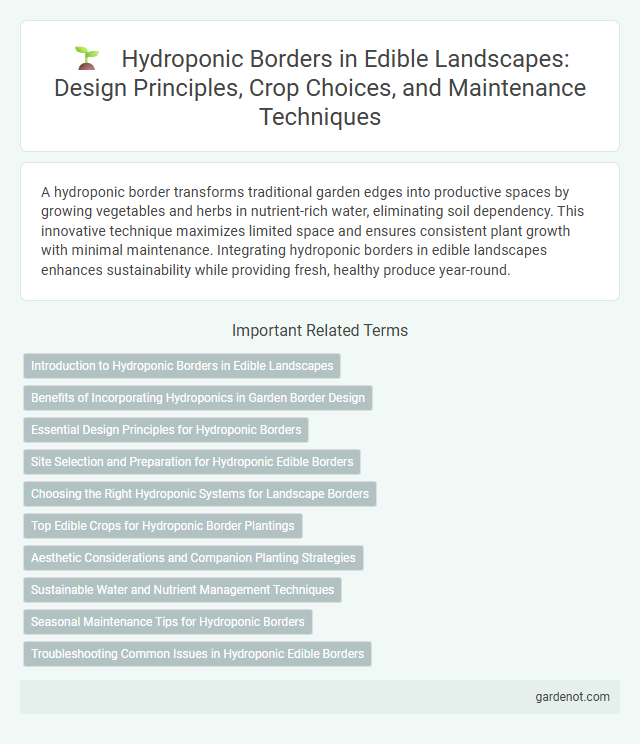A hydroponic border transforms traditional garden edges into productive spaces by growing vegetables and herbs in nutrient-rich water, eliminating soil dependency. This innovative technique maximizes limited space and ensures consistent plant growth with minimal maintenance. Integrating hydroponic borders in edible landscapes enhances sustainability while providing fresh, healthy produce year-round.
Introduction to Hydroponic Borders in Edible Landscapes
Hydroponic borders in edible landscapes utilize soil-free growing techniques to cultivate vegetables, herbs, and edible plants, maximizing space efficiency and nutrient control. These systems rely on nutrient-rich water solutions circulated through channels or containers, enabling faster growth and higher yields compared to traditional soil gardening. By integrating hydroponic borders, gardeners can create sustainable, visually appealing food-producing barriers that contribute to urban agriculture and reduced water usage.
Benefits of Incorporating Hydroponics in Garden Border Design
Incorporating hydroponics in garden border design maximizes space efficiency by enabling vertical and compact plant growth without soil, significantly reducing water use by up to 90% compared to traditional gardening. Hydroponic borders enhance plant health through precise nutrient control, resulting in faster growth cycles and higher yields of edible crops such as leafy greens, herbs, and strawberries. This modern technique also minimizes pest and disease exposure, promoting a cleaner, more sustainable edible landscape with reduced reliance on chemical pesticides.
Essential Design Principles for Hydroponic Borders
Hydroponic borders require careful selection of nutrient-rich growing mediums and consistent water circulation systems to ensure optimal plant growth and health. Strategic placement of plants with complementary nutrient needs enhances resource efficiency and maximizes yield in limited space. Incorporating proper lighting and temperature control further supports sustainable and productive hydroponic edible landscapes.
Site Selection and Preparation for Hydroponic Edible Borders
Selecting a site for hydroponic edible borders requires ample natural light, ideally 6-8 hours daily, to maximize nutrient uptake and plant growth. The location must have consistent access to clean water and be sheltered from strong winds to prevent damage and moisture loss. Preparing the site involves ensuring a level surface with proper drainage and setting up a controlled environment for temperature and humidity to optimize hydroponic system efficiency.
Choosing the Right Hydroponic Systems for Landscape Borders
Selecting the right hydroponic system for landscape borders involves evaluating factors such as space availability, plant types, and water efficiency to maximize growth and yield. Nutrient film technique (NFT) systems are ideal for shallow-rooted leafy greens, while deep water culture (DWC) suits larger plants requiring more oxygenation. Optimizing system choice enhances sustainability in edible landscapes by reducing soil dependence and enabling year-round production.
Top Edible Crops for Hydroponic Border Plantings
Lettuce, spinach, and kale thrive in hydroponic border systems due to their fast growth and nutrient absorption efficiency. Herbs such as basil, mint, and cilantro perform exceptionally well, enhancing both flavor and aesthetics in edible landscapes. Strawberries and cherry tomatoes also flourish, providing high yields with minimal soil requirements.
Aesthetic Considerations and Companion Planting Strategies
Hydroponic borders in edible landscapes enhance aesthetic appeal by creating clean, organized lines with vibrant, healthy plants that thrive without soil, showcasing lush greenery and colorful produce. Incorporating companion planting strategies such as pairing herbs like basil with tomatoes improves growth and pest resistance while adding visual variety through contrasting textures and colors. Thoughtful arrangement of compatible species not only maximizes space efficiency but also promotes a balanced ecosystem, making the hydroponic border both functional and visually striking.
Sustainable Water and Nutrient Management Techniques
Hydroponic borders utilize recirculating water systems that significantly reduce water consumption compared to traditional soil gardening, achieving up to 90% savings. These systems integrate precise nutrient dosing to optimize plant uptake and minimize runoff, ensuring efficient use of fertilizers and reducing environmental impact. Advanced sensors and automation in hydroponic setups enable real-time monitoring of water quality and nutrient levels, promoting sustainable water and nutrient management in edible landscapes.
Seasonal Maintenance Tips for Hydroponic Borders
Hydroponic borders require regular monitoring of nutrient levels and pH balance to ensure optimal plant growth throughout each season. Seasonal maintenance includes cleaning the system to prevent algae buildup and adjusting light exposure according to the changing natural daylight patterns. Inspecting and replacing any damaged components, such as pumps or tubing, ensures continuous water circulation and nutrient delivery in the hydroponic border system.
Troubleshooting Common Issues in Hydroponic Edible Borders
Hydroponic edible borders often encounter nutrient imbalances, root rot, and pH fluctuations that can stunt plant growth and reduce yield. Regular monitoring of nutrient solution composition, maintaining oxygen levels in the water, and stabilizing pH between 5.5 and 6.5 help prevent common problems. Implementing automated sensors and timely adjustments ensures a healthy, productive hydroponic edible landscape.
Hydroponic border Infographic

 gardenot.com
gardenot.com